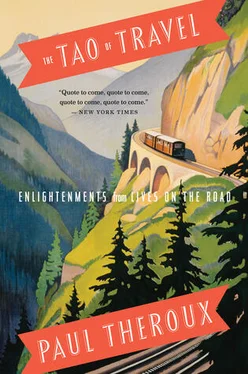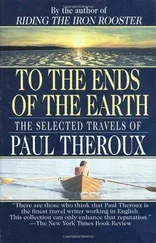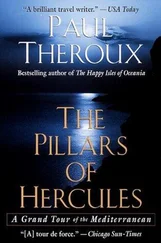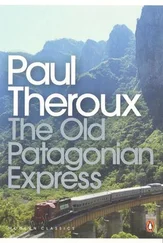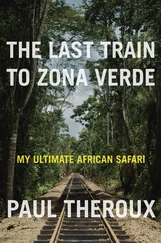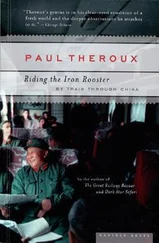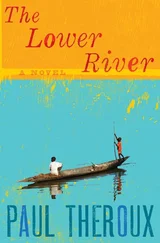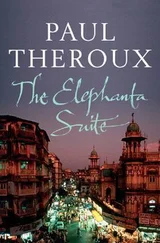Paul Du Chaillu in West Africa: Three years. Born in New Orleans (this is disputed; it might have been Paris) in 1835, he spent part of his youth in West Africa, where his father was a trader. He set off in 1855, when he was twenty years old. "I traveled — always on foot, and unaccompanied by other white men — about 8,000 miles. I shot, stuffed, and brought home over 2,000 birds, of which more than 60 are new species, and I killed upwards of 1,000 quadrupeds, of which 200 were stuffed and brought home, with more than 60 hitherto unknown to science. I suffered fifty attacks of the African fever, taking, to cure myself, more than fourteen ounces of quinine. Of famine, long-continued exposures to the heavy tropical rains, and attacks of ferocious ants and venomous flies, it is not worth while to speak." He traveled in and around Gabon and halfway up the Ogowe (or Ogooue) River, 300 miles into the African interior, where he confirmed the existence of several species of gorilla (Explorations and Adventures in Equatorial Africa, 1861). On a later trip, for another book, he encountered various bands of Pygmies (The Country of the Dwarfs, 1871).
He inspired the travels of Mary Kingsley, H. M. Stanley, Jack London, and many others, and perhaps the fiction of Saul Bellow, whose Henderson the Rain King seems to echo the account of Du Chaillu's being made king of the Apingi in Gabon (see Chapter 21, "Writers and the Places They Never Visited").
Sir Ernest Shackleton's Endurance Expedition: Almost three years, 1914–1917. One of the most moving parts of South (1920), Shackleton's account of this heroic journey, is his sense that there was a mysterious fourth person with him on one of his marches:
When I look back at those days I have no doubts that Providence guided us, not only across those snow fields, but across the storm-white sea that separated Elephant Island from our landing-place on South Georgia. I know that during that long and racking march of thirty-six hours over the unnamed mountains and glaciers of South Georgia it seemed to me often that we were four, not three. I said nothing to my companions on the point, but afterwards Worsley said to me, "Boss, I had a curious feeling on the march that there was another person with us." Crean confessed the same idea. One feels "the dearth of human words, the roughness of mortal speech" in trying to describe things intangible, but a record of our journeys would be incomplete without a reference to a subject very near to our hearts.
Without crediting it precisely, T. S. Eliot alludes to the phenomenon in a line of The Waste Land: "Who is the third who always walks beside you?" In a footnote Eliot writes that the line "was stimulated by the account of one of the Antarctic expeditions (I forget which but I think one of Shackleton's)."
Tobias Smollett in France and Italy: Two years, 1763–1765.
When a book reviewer criticizes a travel book for being negative, I always think of Smollett, who forcibly spoke his mind, as in this observation of the French character:
If a Frenchman is admitted into your family, and distinguished by repeated marks of your friendship and regard, the first return he makes for your civilities is to make love to your wife, if she is handsome; if not, to your sister, or daughter, or niece. If he suffers a repulse from your wife, or attempts in vain to debauch your sister, or your daughter, or your niece, he will, rather than not play the traitor with his gallantry, make his addresses to your grandmother; and ten to one, but in one shape or another, he will find means to ruin the peace of a family, in which he has been so kindly entertained.
— Travels Through France and Italy (1766)
C. M. Doughty in Arabia Deserta: Twenty-one months, 1876 to 1878, and it took him ten years to write his masterpiece, Travels in Arabia Deserta (1888).
T. E. Lawrence in Arabia: For The Seven Pillars of Wisdom, one year, 1916 to 1917. He wrote the first version of the book in 1919, and lost it when he misplaced his briefcase at a railway station while changing trains. He wrote a second version in 1920, which he rewrote the following year. Eventually a much-shortened version was published in 1926.
This, like other great travel books, is not a travel book in any conventional sense. Subtitled "A Triumph," it is the record of Lawrence's involvement in the Arab revolt against the Ottoman Turks. But in the tradition of Doughty, whom Lawrence idolized, it describes the moods of the desert, the life of the Bedouin, and the subtleties of Islam, as well as military tactics. Lawrence's own contradictory character is a subject, and he is unsparing with himself.
"I was very conscious of the bundled powers and entities within me; it was their character which hid. There was my craving to be liked — so strong and nervous that never could I open myself friendly to another… There was a craving to be famous; and a horror of being known to like being known. Contempt for my passion for distinction made me refuse every offered honor." In this same section ("Myself") he adds, "I liked the things underneath me and took my pleasures and adventures downward. There seemed a certainty in degradation, a final safety. Man could rise to any height, but there was an animal level beneath which he could not fall."
Charles Dickens in Italy: Eleven months, to gather material for Pictures from Italy, 1844–45. He needed to get away from London because his sales of Martin Chuzzlewit were poor and casting a pall over his writing. He had been very discouraged by the negative, even hostile reviews of American Notes (1842). He witnessed a beheading in Rome and gave a detailed account of it, including this, the moment of truth:
[The condemned man] immediately kneeled down, below the knife. His neck fitting into a hole, made for the purpose, in a cross plank, was shut down, by another plank above; exactly like the pillory. Immediately below him was a leathern bag. And into it his head rolled instantly.
The executioner was holding it by the hair, and walking with it round the scaffold, showing it to the people, before one quite knew that the knife had fallen heavily, and with a rattling sound.
When it had traveled round the four sides of the scaffold, it was set upon a pole in front — a little patch of black and white, for the long street to stare at, and the flies to settle on. The eyes were turned upward, as if he had avoided the sight of the leathern bag, and looked to the crucifix. Every tinge and hue of life had left it in that instant. It was dull, cold, livid, wax.
André Gide in Africa: Ten months, 1925–26, for Travels in the Congo (1929), the English edition of which includes Voyage au Congo and Le Retour du Tchad.
Gide had traveled at the official invitation of the French government, and yet this did not restrain him from criticizing colonial policies, or reporting on the many abuses of power against the African subjects (whippings, beatings, arson, intimidation), or the French colonial officers' taking advantage of Africans. It must be added that Gide, too, who fancied adolescent boys, indulged himself throughout the trip — and he was traveling with his much younger lover, Marc Allegret. Gide said to a friend that he was "very attracted, if I might dare to say, in a sensual way as well, by the Negro race."
To another correspondent he wrote — and this is true of a great deal of other travelers' experiences—"Everything that I expected to give me delight and which… persuaded me to undertake the journey has disappointed me — but out of that very disappointment… I have acquired an unexpected education."
Читать дальше
